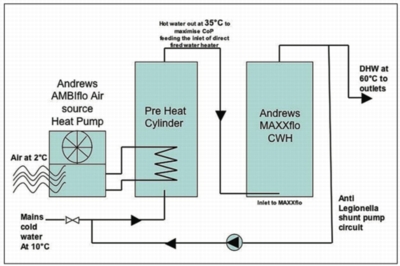A new opportunity for air-source heat pumps

Paul Hardy argues that air-source heat pumps should be considered as part of hot-water generation in buildings, rather than just thinking of solar thermal
As the insulation and air tightness of new buildings continues to improve, space-heating loads fall. Hot water is fast becoming the dominant thermal load in commercial buildings, so it seems logical that low- and zero-carbon (LZC) technologies should support the generation of hot water.
In the commercial sector, solar thermal systems are becoming a common feature on new buildings to reduce primary energy and carbon emissions. The key drivers are increasingly stringent Building Regulations and local-authority planning consent, the latter often stipulating that 10% to 20% of a property’s energy needs should be provided by renewable energy. However, solar thermal systems may be not be viable in all cases.
There may be insufficient roof space for the required number of solar collectors or there may be no available south-facing roof. Heat pumps are often only considered for low-grade space-heating solutions such as under-floor heating, particularly in the domestic sector. However, for commercial applications air-source heat pumps could provide a low-carbon solution for producing hot water.
The performance of such heat pumps depends on the ambient air temperature and the outlet temperature of the water on the load side of the system. The coefficient of performance (CoP) of an air source heat pump is typically 3.0 to 3.5. This CoP is based on ambient air at 2°C and a load (water) temperature of 35°C. Air-source heat pumps can achieve water temperatures up to 55°C but the performance of the heat pump would be seriously compromised and its CoP significantly reduced. This is a key issue and has a huge bearing on the environmental and economic benefits offered by air-source heat pumps.
CO2 emissions from centralised power generation based on the current UK mix is around 0.43 kg/kWh. For natural gas CO2 emissions are 0.193 kg/kWh. The ratio between the two factors is about 2.2. If an air-source heat pump displaces natural gas burned in a boiler or water heater, as it uses electricity as its primary energy source, then if the CoP is less than 2.2 the application of the heat pump would actually emit more carbon. When considering the economic case for air source heat pumps the ratio of the electricity and gas tariffs should also be analysed for similar reasons.
The key is not to expect too much from the heat pump. Control its operation so that the outlet water temperature does not exceed, say, 35°C to maximise the CoP.
For commercial applications where LZC technology does not replace the primary heating appliance entirely, air-source heat pumps can be used for pre-heating.
If an air-source heat-pump circuit is controlled to deliver a flow temperature of 35°C and a return temperature of 25°C, i.e. a differential across the indirect coil of 10 K, you could expect to achieve a potable water temperature of 30°C in the pre-heat cylinder. This would result in a higher water inlet temperature into the direct-fired water heater, reducing fuel consumption by about 40% and significantly impacting the carbon footprint of the hot-water system.

It has to be accepted that there are seasonal variations in air-source heat-pump performance due to fluctuations in ambient air temperatures throughout the year. However the CoP stated earlier is based on an ambient air temperature of 2°C; for most of the year the temperature will be higher, leading to a higher CoP.
Different manufacturers and suppliers use a different ambient air temperature as the basis for CoPs, so be aware of this when considering applications for air-source heat pumps and the potential benefits available.
Building Regulations and planning consent are driving the UK commercial heating and ventilation sector to adopt LZC solutions. However, there is also a vast stock of existing commercial buildings where low-efficiency heating and hot-water systems would greatly benefit from the application of heat-pump technology. Energy Performance Certificates and Display Energy Certificates will eventually and inevitably stimulate an uptake of renewables in existing buildings.
The application of ground-source heat pumps is largely limited to the new buildings because of the need for a ground loop, whether this is installed in a series of horizontal trenches or deep bore holes. The enabling works associated with the ground loop prohibits the uptake of ground-source heat pumps for existing buildings. This is not the case for air-source heat pumps which supports their application in the retrofit market as does the ability to install the heat pump outdoors or on a roof-top.
Air-source heat pumps can offer a viable alternative to solar thermal solutions on new commercial projects, but they can also help reduce the carbon footprint of existing buildings.
In both scenarios the key to delivering the carbon benefit is controlling the outlet operating temperature and optimising the CoP. By not expecting too much from the heat pump and harmonising its operation with the primary heating appliance, low-carbon hot-water solutions can be achieved.
Paul Hardy is managing director of Andrews Water Heaters and Potterton Commercial.







